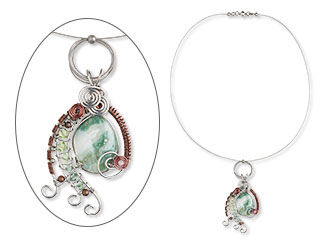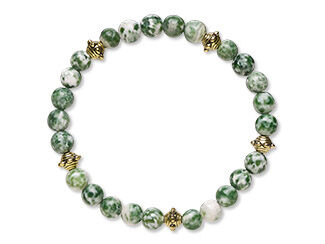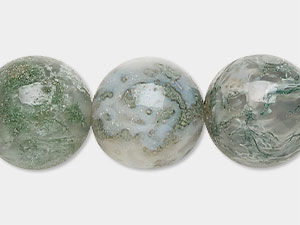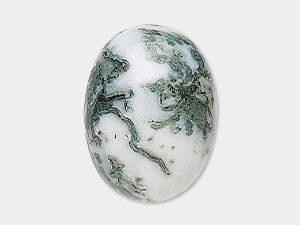Agate, Tree Meaning and Properties
Tree Agate History
Tree agate is also known as dendritic agate. Dendrites are crystal inclusions that develop in foliage or tree branch-like patterns. In tree agate, these dendrites create a beautiful green dappling effect on a white base. This gorgeous green and white stone has long been seen as having a deep connection to nature and was therefore viewed as the stone of plentitude by many civilizations. The ancient Greeks associated tree agate with dryads, and the stone was sometimes buried in agricultural fields to promote a plentiful harvest.
The name agate itself harkens back to antiquity and the Achates River in Sicily where agates are thought to have been found. At least 3000 years ago, the Egyptians were making seals, rings and vessels from agate stones. Agate was not just a decorative stone and was long used as talismans in Egypt, Greece and India.
What are the Metaphysical Properties of Tree Agate?
Just as a dappled forest may bring calmness, so tree agate meaning is thought to include a sense of peace and inner tranquility for those who wear it. This gemstone helps individuals look inside for self-examination, which also may result in a calm demeanor. Agate in general is said to be a stone that promotes inner stability, making tree agate an amplified version. Tree agate is also believed to boost the immune system and balance water in the body.
Agate gemstones in general are believed to have a quiet energy associated with the heart chakra. Agate is thought to strengthen relationships, promote composure and offer a warm, protective quality to the wearer.
What Chakra is Tree Agate?
Chakras are believed to be energy centers within the body that influence both physical vitality and emotional well-being. Wearing a bracelet adorned with gemstones connected to a specific chakra is said to support balance—easing the mind, grounding the body and opening the spirit. Tree agate is traditionally linked to the heart chakra, the energetic center of compassion, connection and emotional healing. Known for its soothing green patterns reminiscent of forest foliage, tree agate meaning is thought to include promoting inner peace, patience and a deep-rooted sense of harmony with the natural world.
Heart Chakra (Anahata) - Green
- Location: chest (breastbone)
- Represents: the union of male and female principles; ability to love
- Emotional issues: compassion; trust; forgiveness; compassion; complex emotions; tenderness; equilibrium; love
- Spiritual issues: devotion
- Physical issues: immune system; cardio-vascular system; lungs
- Gemstones: amazonite, aventurine, green agate, jade, malachite, moss agate, peridot, rhodonite, rhodochrosite, rose quartz, tree agate
What is Tree Agate Made From?
The distinctive inclusions that resemble vegetation in dendritic agate are a result of the presence of manganese and iron oxides finding their way into cracks of white quartz as it forms. Tree agate has a hardness of 6-1/2 to 7 with a specific gravity of 2.60 to 2.65. This type of agate is frequently mistaken for moss agate, but these stones have different mineral traces creating the unique green branch-like patterns. Tree agate is most commonly found in Brazil, China, India, Australia, Kazakhstan, Madagascar, Mexico, Mongolia, Namibia, Uruguay and the United States.
- Mineral Information: Microcrystalline quartz, banded chalcedony
- Chemical Composition: SiO2
- Color: White base with dappled green inclusions
- Hardness: 6-1/2 to 7 (Mohs)
- Specific Gravity: 2.60 – 2.65
- Refractive Index: 1.544 – 1.553
How Do You Clean Tree Agate?
Agates are generally tough stones, but the best cleaning method for tree agate is to simply use warm, soapy water and a soft brush. It is not recommended to use harsh chemicals when cleaning agate gemstones. Be sure to thoroughly dry tree agate jewelry after cleaning to ensure there is no residual moisture that could cause adverse reactions such as rust in metal settings. Store tree agate jewelry inside a soft cloth or at least away from other stones so as not to run the risk of scratching this agate against a harder stone or of scratching a less hard stone.
Tree Agate FAQ
Q: Where is tree agate found?
A: Tree agate is most commonly found volcanic regions all over the world, including Brazil, China, India, Australia, Kazakhstan, Madagascar, Mexico, Mongolia, Namibia, Uruguay and the United States.
Q: Is tree agate hard enough for a bracelet?
A: With a Mohs hardness of 6-1/2 to 7, tree agate is hard enough to endure everyday wear.
Q: Does tree agate have inclusions?
A: Tree agate is known for its beautiful inclusions that mimic the look of the foliage of trees.
Q: Is tree agate used in cottagecore jewelry?
A: With its swirls of milky white and deep forest green, tree agate is a natural fit for cottagecore jewelry—evoking enchanted forests, quiet woodland paths and the timeless charm of fairytale folklore.
Designing with Tree Agate
Tree agate is a fun stone to design with, especially since each has unique inclusions. The amount of green on each bead can affect design decisions. If a tree agate stone is mostly white with only minor green dendrites, pairing this gemstone with more solid green gemstones will help to bring attention to the bit of green. This works in the opposite way as well—if the stone is mostly green with only a dappling of white, pair the stone with snow quartz or white howlite to make the white in your tree agate more prominent.
Since tree agate has a deep connection to nature, other earthy palettes work exceptionally well. Floral tones, browns, and sky or deep-water blues all create an ambience of connecting with nature. Brighter purples and reds are complementary colors to the green of tree agate and can make a striking contrast in jewelry designs.
A Few Design Inspirations to Get You Started
Shop for Tree Agate
**Please note that all metaphysical or healing properties listed are collected from various sources. This information is offered as a service and not meant to treat medical conditions. Fire Mountain Gems and Beads® does not guarantee the validity of any of these statements.
How did you like this resource? Your feedback helps us provide resources that matter to you most.
Copyright Permissions
All works of authorship (articles, videos, tutorials and other creative works) are from the Fire Mountain Gems and Beads® Collection, and permission to copy is granted for non-commercial educational purposes only. All other reproduction requires written permission. For more information, please email copyrightpermission@firemtn.com.





